In the night moon and red lights on the border guard radar shine into my bed.
I sleep long and with pleasure. Birds already sing when I wake up. If they ever stopped.
Toomas is installing the toilets.
I walk to Saare village and Valentina happens to be in the museum. She lives in the other half of it because the house belonged to her great-grandfather. There are family pictures on the wall. First of celebrating 12th of July, Peter and Paul day which is very important for oldbelivers. In the picture from 1941 are two Estonian flags. Russian occupation had started already in June. One of Valentina’s grandfathers was in Communist Party, the other fighting in the German army with Defence League. People made their choices and little ideology was involved. Russians and Estonians both are „others“.
The island has been inhabited from 13th century and was three times as big until a huge flood in 19th century took most of the sand away, including the old cemetery. The inhabitants are „original“ oldbelievers and have not escaped from Russia. After the reform of course refugees also came but because their co-religionists were already here. Although the reform issues sound trivial today it was a sign of unification of an empire in creation and resisting people were killed and villages burnt.
Religious education was given in Riga but the upbringing was such that Valentina’s grandfather went there only for the exams. He wrote textbooks for throat singing by hand. All books are in old-slavic and Valetina thinks it’s about time to translate these in Russian otherwise young people don’t understand anything. For some reason oldbelievers haven’t registered as a church but act in the form of an ordinary non-profit organization and translating hasn’t found support there.
Soviet repressions went over the island as in other parts of Estonia but since here were no big farms, shopkeepers and merchants were sent to Siberia, collaborators with Germans also shot on the spot.
The making of collective farms wasn’t traumatic because doing things with the community was a habit so life didn’t at first change much.
Here lived once 2000 people, now only a few dozen. No school here now (here were three) and no work, ferry connection does not enable people to work on mainland and live on the island. Residents are all retired people, younger ones come on weekends and in summer.
The museum shows an ordinary living house where everything was very clean with white carpets and laced curtains. In the middle of the table sits a gorgeous samovar. An obligatory piece in every household is an icon. It is ordered already when the house is being built. Here is an icon painted by Mark Solntsev who was from Frolov school. Another of Frolov’s pupil, Pimen Sofronov was invited to paint an icon in Vatikan which is now in the living quarters of the pope. The same Pimen who is still remembered in Raja village.
Canal through the island was digged while Päts was president (1930ies) because water is so low that big fishing boats could not come close to the shore and had to be unloaded with small boats. It was digged only half-way at first and all the way through during soviet time.
The museum is based only on enthusiasm and enterpreneurship of Valentina. She also does excursions on the island and offers meals when pre-booked. She has managed to wriggle through necessary paperwork which is an achievement in itself. All profit goes to restore the small church which was burnt three years ago. Her main job is a bookkeeping firm in Tallinn.
We drink tea from samovar, holding a limp of sugar in the mouth as is local custom. Finally Valentina has other business to attend to and I wander off by myself.
A sign points to the beach. There’s a man with binoculars on his chest, grey coat reaching his knees, wearing a baseball cap with New York written on it and a whistling hearing aid. That’s Vassili and he’s 90 years old. Looks with binoculars into Russia. He remembers times when there lived a lot of people on the island and young boys had to herd cows, when war came and the Germans and the Russians and again Estonian Republic. Logs for building a house were brought with horses or rafting from Järvselja or from Russia, shopping was also done in Russia. Payment method was fish. The amount of people has all the time grown less and also water level has sunk. Before water reached, look, until these stones. Pension has increased, the main thing is to be healty. He talks long about how things were, gets tired and walks away.
I sit on a rock and look at swallows and white wagtails busy themselves on the water’s edge. A white heron appears by the reed, sneaks and searches for something in the water and flies towards Russia after finding nothing. Noise of ducks comes from the reed.
I go back to my vigvam to make soup and read. It is a resting day after all.
In the evening I walk through Piiri village. Guardian of the island is smoking fish in a bucket. He has been on the island just over a month and was working in Finland before. His wife is a doctor and works in Finland until they manage to sell the house. Then she comes to live here. She saw elks in the canal earlier. More animals in addition to the wild boar who has digged up part of the campsite. She gives me pieces of pike they fried yesterday. I eat it with buckwheat that has been in water all day. Bittern makes noise somewhere close.
Toomas is installing the toilets.
I walk to Saare village and Valentina happens to be in the museum. She lives in the other half of it because the house belonged to her great-grandfather. There are family pictures on the wall. First of celebrating 12th of July, Peter and Paul day which is very important for oldbelivers. In the picture from 1941 are two Estonian flags. Russian occupation had started already in June. One of Valentina’s grandfathers was in Communist Party, the other fighting in the German army with Defence League. People made their choices and little ideology was involved. Russians and Estonians both are „others“.
The island has been inhabited from 13th century and was three times as big until a huge flood in 19th century took most of the sand away, including the old cemetery. The inhabitants are „original“ oldbelievers and have not escaped from Russia. After the reform of course refugees also came but because their co-religionists were already here. Although the reform issues sound trivial today it was a sign of unification of an empire in creation and resisting people were killed and villages burnt.
Religious education was given in Riga but the upbringing was such that Valentina’s grandfather went there only for the exams. He wrote textbooks for throat singing by hand. All books are in old-slavic and Valetina thinks it’s about time to translate these in Russian otherwise young people don’t understand anything. For some reason oldbelievers haven’t registered as a church but act in the form of an ordinary non-profit organization and translating hasn’t found support there.
Soviet repressions went over the island as in other parts of Estonia but since here were no big farms, shopkeepers and merchants were sent to Siberia, collaborators with Germans also shot on the spot.
The making of collective farms wasn’t traumatic because doing things with the community was a habit so life didn’t at first change much.
Here lived once 2000 people, now only a few dozen. No school here now (here were three) and no work, ferry connection does not enable people to work on mainland and live on the island. Residents are all retired people, younger ones come on weekends and in summer.
The museum shows an ordinary living house where everything was very clean with white carpets and laced curtains. In the middle of the table sits a gorgeous samovar. An obligatory piece in every household is an icon. It is ordered already when the house is being built. Here is an icon painted by Mark Solntsev who was from Frolov school. Another of Frolov’s pupil, Pimen Sofronov was invited to paint an icon in Vatikan which is now in the living quarters of the pope. The same Pimen who is still remembered in Raja village.
Canal through the island was digged while Päts was president (1930ies) because water is so low that big fishing boats could not come close to the shore and had to be unloaded with small boats. It was digged only half-way at first and all the way through during soviet time.
The museum is based only on enthusiasm and enterpreneurship of Valentina. She also does excursions on the island and offers meals when pre-booked. She has managed to wriggle through necessary paperwork which is an achievement in itself. All profit goes to restore the small church which was burnt three years ago. Her main job is a bookkeeping firm in Tallinn.
We drink tea from samovar, holding a limp of sugar in the mouth as is local custom. Finally Valentina has other business to attend to and I wander off by myself.
A sign points to the beach. There’s a man with binoculars on his chest, grey coat reaching his knees, wearing a baseball cap with New York written on it and a whistling hearing aid. That’s Vassili and he’s 90 years old. Looks with binoculars into Russia. He remembers times when there lived a lot of people on the island and young boys had to herd cows, when war came and the Germans and the Russians and again Estonian Republic. Logs for building a house were brought with horses or rafting from Järvselja or from Russia, shopping was also done in Russia. Payment method was fish. The amount of people has all the time grown less and also water level has sunk. Before water reached, look, until these stones. Pension has increased, the main thing is to be healty. He talks long about how things were, gets tired and walks away.
I sit on a rock and look at swallows and white wagtails busy themselves on the water’s edge. A white heron appears by the reed, sneaks and searches for something in the water and flies towards Russia after finding nothing. Noise of ducks comes from the reed.
I go back to my vigvam to make soup and read. It is a resting day after all.
In the evening I walk through Piiri village. Guardian of the island is smoking fish in a bucket. He has been on the island just over a month and was working in Finland before. His wife is a doctor and works in Finland until they manage to sell the house. Then she comes to live here. She saw elks in the canal earlier. More animals in addition to the wild boar who has digged up part of the campsite. She gives me pieces of pike they fried yesterday. I eat it with buckwheat that has been in water all day. Bittern makes noise somewhere close.
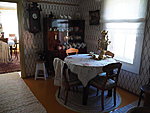
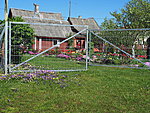
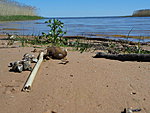
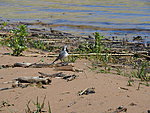
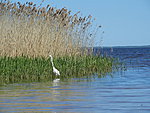
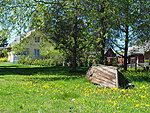
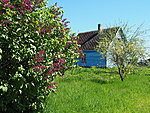
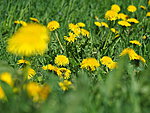
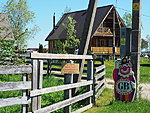
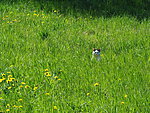
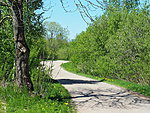
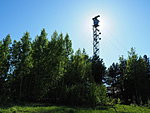
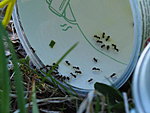
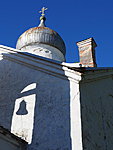
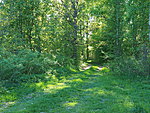
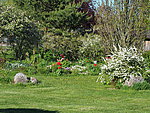
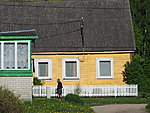
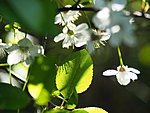
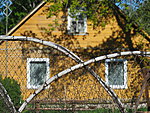
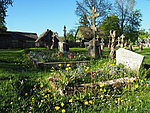
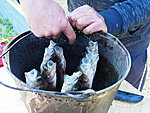
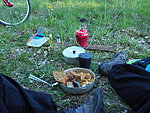
Add a comment